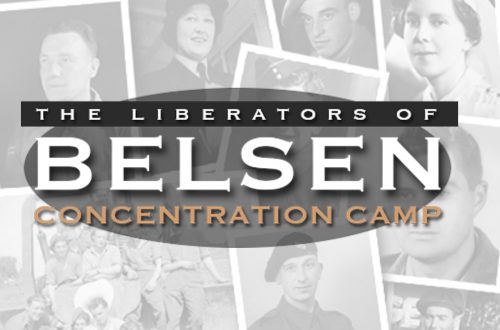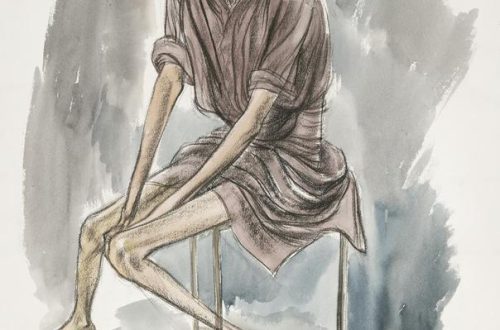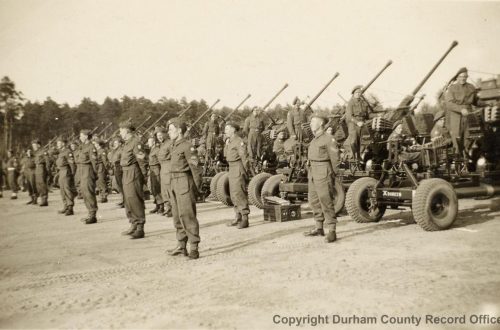
Report on Belsen Camp by Lt. Col. Taylor
REPORT ON BELSEN CAMP
by Lt-Col. R.I.G. TAYLOR, DSO, MC.
Appendix ‘A’ attached is a short account of the condition of the camp as known before the entry on 15 April.
Appendix ‘B’ is a copy of the agreement concluded between representatives of the Allied and German Armies on 12 April 1945.
PART I.
On 13 April I received written instructions from B.G.S., 8 Corps that I was to assume control of the area as given in the agreement, that I was to command all enemy troops remaining in the area, and “in principle British troops were to be employed to give authority of enemy forces vis a vis other British troops rather than assume guard responsibilities themselves”.
I was ordered to take one towed Anti-Tank Bty with me and selected 249 (Oxfordshire Yeomanry) Bty, commanded by Major B.C. Barnett.
Early on 14 April I joined the Bty. in 11 Armd Div area near ISSEL, but it was not until approximately mid-day on 15 April that our forward troops penetrated the area which was to be regarded as neutral. 11 Armd Div provided a loudspeaker van which joined me at this location.
At 1330 hrs an L.O. (Capt P.T. Ashton) was sent immediately behind 23 H, to contact the Camp Commandant, Oberst HARRIES, and to arrange for the latter to meet me at the entrance to the camp.
I took with me 2 troops of Crusader towed 17-prs, leaving the third troop and all the ‘soft’ vehicles to follow later. I also had an escort of 1 NCO and 6 men.
Upon contacting Oberst Harries I explained to him, through an interpreter, that I was the Allied Military Commander and demanded to be shown quarters for my troops. I had previously arranged that the loudspeaker should broadcast a message from the Corps Commander as soon as it was possible to enter the camp.
I demanded a nominal roll of all Wehrmacht and Hungarian troops which was promised by the following morning. I learnt that their strengths were approximately 800 and 3,000 respectively. Of the 800 Wehrmacht a large proportion were entirely administrative personnel and were not considered by the Commandant as capable of bearing arms.
In reply to further questions Oberst Harries stated:-
(a) The S.S. were solely responsible for, and had complete control of, the Concentration Camps, and dealt with all administration.
(b) He merely acted as L.O. between the S.S. and the ‘army’ (presumably the Wehrmacht).
(c) Oberst Shmidt the second-in-command held a similar position liaising between the S.S. and the Hungarian troops.
(d) The camps were at the moment quiet and so far as he knew no prisoners had escaped.
(e) He could give no details of figures or records of the internees as the S.S. were in complete control.
(f) Sentries and notices of ‘TYPHUS – DANGER’ had been posted on all roads leading to the camp. He was ordered to see that these sentries remained at their posts until further notice.
(g) Outside telephone lines had been cut on the arrival of the first British troops. This was NOT checked.
Immediately after the interview a PHANTOM officer arrived with information that there was shooting in Camp 1.
A S.A.S. Officer at the same time reported that he had found a soldier of his unit who was a prisoner in Camp 1. He was given permission to remove this man, by name Jenkinson, and later reported that he had done so.
I, together with Major Barnett and Oberst Harries and the escort proceeded immediately to Camp 1, where I met the S.S. leader, KRAMER. He stated that his men were armed, and that if they were disarmed they could not administer the camp, as they would be overpowered by the internees. In view of the fact that there was no alternative form of administration available I agreed that they should temporarily retain their arms. He stated that his men worked in the cookhouses, and did all the administration in the camp.
I immediately ordered a troop of 249 (Oxfordshire Yeomanry) Bty to move to the camp to keep order, and arranged for them to occupy the best billets.
KRAMER was then told that all shooting inside the camp was to stop and I would hold him personally responsible for any man killed. I explained that the troop would help with the work of administering the camp and would assist in keeping order.
The S.S. leader was then ordered to accompany myself, Major Barnett, the interpreter and escort to his office.
In answer to questions he stated:-
(a) All papers with regard to the prisoners had been destroyed on orders from Berlin, having previously stated that 2,000 papers were available. When asked why he said this he stated he did not know the order had been carried out.
(b) There were approximately 40,000 men and women in the camp, a large proportion of whom had only recently arrived from another camp that had been over-run.
(c) There was enough food in the camp to feed the prisoners for 3 days.
(d) So far as he knew no prisoners had escaped.
(e) There were approximately 25 S.S. personnel administering the camp. A nominal roll was asked for and when this was produced it showed 50 names. No physical check was made of S.S. personnel.
About this time Brig. HUGHES (DDMS Second Army) arrived.
A report was received that there was rioting in one of the cookhouses and that a quantity of food had been stolen. Accompanied by Brig. Hughes and the rest of my party, together with KRAMER, we set off for the cookhouse.
The living quarters of the S.S., both men and women, and the Wehrmacht guards are separated from the Concentration camp proper by a 10 foot high barbed wire fence. Hungarian guards were posted on the gate.
An occasional shot was being fired from inside the camp, and on passing through the gates we saw the camp and the internees for the first time.
I later discovered that the camp was divided into 6 blocks. Each block being separated from the other barbed wire. There were 4 women’s blocks, 2 mens – there being 5 cookhouses in all.
Inside these wire cages were approximately 100 huts, some with bunks and some without. It was quite impossible for all the internees to enter the hut allotted to them at the same time, a large proportion were therefore living in the open.
As we walked down the main roadway of the camp we were cheered by the internees, and for the first time we saw their condition.
A great number of them were little more than living skeletons, with haggard yellowish faces. Most of the men wore a striped pyjama type of clothing – others wore rags, while the women wore striped flannel gowns, or any other garment that they had managed to acquire. Many of them were without shoes and wore only socks and stockings.
There were men and women lying in heaps on both sides of the track. Others were walking slowly and aimlessly about – a vacant expression on their starved faces.
There was a concrete pit near the first cookhouse we visited, with a few inches of dirty water in the bottom – this was the only water supply that was seen, and crowds were round it trying to fill tins and jars tied to the end of long sticks.
On arrival at the first cookhouse we found the place practically deserted. I saw one copper three quarters full of soup made of turnips and potatoes. This was the theft and rioting reported by the S.S.!
Still the occasional shot was ringing out as we made our way further down the camp towards the potato patch. This consisted of a few rows of potatoes covered by earth, and on it were lying 6 or 7 corpses which had obviously just been shot. There were other living skeletons that had been wounded, and who were crying out with pain. No attempt was being made to relieve their distress, although S.S. troops were in the vicinity.
After a little gentle persuasion the internees returned to their blocks, and it was while this was going on that I met a French girl who I knew. She had been seized from her flat in Paris 18 months previously for helping Allied officers to escape.
I later learnt from her that the S.S. women were as cruel as the men. As an example, when working in another camp near Berlin they would only allow the internees to lie down for 2 hours each night – for the remainder of the time they were made to stand up. Thousands of internees were dying daily and it was three days since she had had any food. Her hair had been cropped twice, and women internees were made to drag corpses to the big open grave.
By this time it was after 2100 hours, and getting very dark, and we returned to our own quarters.
I later ordered KRAMER to be placed under close arrest, and confined to his own sitting room.
I then despatched an L.O. to Corps H.Q. with an urgent request for food and water, and further military aid.
At 0830 hours on 16 April after picking up Harris, Brig. Hughes and myself went to Camp 1. I had previously been informed that 172 L.A.A. Bty was on its way to the camp.
I ordered a second troop of 249 Bty to the camp.
My Troop Commander informed me that he did not think anyone had been shot during the night, but many had obviously died of starvation, and were lying dead along the main roadway and also behind the barbed wire of their cages.
KRAMER was placed in a jeep with 3 military policemen and led us to the crematorium. This consisted of a single furnace which owing to shortage of coal had not been used for some weeks. Nearby was a covered in grave.
There was no sanitation of any sort in the camp, not even trenches for use as latrines.
Lt-Col. Michie (A.D.H. 8 Corps) later reported that he had seen figures indicating that 17,000 bodies had been cremated during March.
We then drove through the womens camp and saw 2 large piles of naked corpses and the uncovered pit some distance further on.
There were heaps of dead in every cage and it was quite obvious that unless food and water arrived soon the whole camp would starve to death.
A message was broadcast telling the internees that food and water were on the way, the German rule in the camp was over and that we were doing everything in our power to relieve their misery.
Brig. Hughes and I then made a short tour of Camp 2, which had only been formed a week previously.
Here conditions were very much better, the internees living in stone barracks, guarded by Hungarians, but it was quite obvious at a glance that the majority were starved almost beyond recognition.
I interviewed the S.S. leader who produced a nominal roll of S.S. personnel with 34 names on it, in spite of the fact that he declared he only had less than half that number in the camp.
In reply to questions he said:-
(1) There were 15,133 internees in the camp, and no women.
(2) There was food of sorts for 1 week, but this consisted chiefly of potatoes, turnips and a little flour, and practically no meat.
(3) Soup was served 3 times daily.
(4) There were 400 Hungarian guards round the camp which he considered sufficient.
The same message as was broadcast in Camp 1 was rebroadcast here, to loud cheers.
I told the S.S. leader that all shooting would stop and I would hold him personally responsible to see that it did, and that for every internee that was killed one S.S. man would be shot.
On returning to my quarters soon after mid-day I ordered one troop of 172 L.A.A. Bty to Camp 2.
The B.C. (Major Chapman) was ordered to place the S.S. leader under escort, and later that day he arrested all S.S. men.
The rest of the day was spent trying to procure, and then issue, food and water to Camp 1. This was eventually achieved and I am certain that most of those capable of walking received something to eat. There was no attempt to rush the food lorries or water carts when they arrived, and it was quite obvious that in spite of their appalling condition the internees were doing all in their power to help us.
So far as I had been able to see the S.S. made no material difference to the administration of the camp so I determined to arrest them forthwith, but by the time the food was issued out it was too dark, and I delayed it until the morning.
However I took the precaution of removing KRAMER from the camp, and placing him in an underground cellar below the officers quarters.
On 17 April the remaining S.S. were arrested in Camp 1, 28 men and 25 women being taken. KRAMER’s deputy was missing from the parade, but was later picked up in the camp disguised as an internee. The whole lot were locked in the cells, just outside the concentration camp proper, much to the delight of the inmates.
The men were later set to work carting the corpses from the camp to the big pit – the women joined them later helping with this job. They were given the same ration at the internees had had prior to our entry. During the first night one committed suicide and 2 more attempted but failed to do so. The following day 2 tried to run away but were immediately shot.
KRAMER after being questioned several times by the F.S.P. was removed by them to CELLE P.O.W. camp on 18 April.
A British internee from the Channel islands who was released stated that he had seen cannibalisation in the camp, and Major Bennett saw a corpse which had had several fleshy parts removed.
The death rate in the camp hospitals on the night 16/17th was reported as approximately 500, and I do not think it an exaggeration to estimate the total deaths during each 24 hours as between 500 and 1000.
PART II.
This part deals only with my dealings with Oberst HARRIES in regard to the return of Wehrmacht troops to their own lines.
Prior to my arrival at the camp, I was given to understand that a large proportion of Wehrmacht troops in the camp were entirely administrative and would remain in their present jobs when the agreement terminated.
Harries informed me that about 500 were so employed and at an interview on 17 April Oberst SHMIDT stated that these men should remain in the camp. He also wrote a letter dated 16 April on this subject (Appendix ‘C’).
Oberst HARRIES informed me, when I asked him, that very few troops under his command wished to return to the battle, they would rather become P.O.W. I did my best to encourage this attitude, promising them transport to the cage after laying down their arms in an official manner.
As a result of this I was informed later by Hauptmann ENDSTHALER, who was the senior officer wishing to return to the Reich, that besides himself only 2 officers and 16 O.Rs wished transport back to their own lines. HARRIES later informed me that this figure had been amended to read 17 Officers and 37 O.Rs.
At 1900 hours (approximately) I received a direct order from the Army Commander that ALL Wehrmacht personnel would be returned to the German lines irrespective of their wishes. This was a counter-order to the one from 8 Corps timed and dated 172359A stating “should German Troops garrisoning BELSEN camp prefer to become P.W. rather than return to the REICH they will be accorded this privilege.”
I therefore ordered all Wehrmacht personnel to parade the following morning at 0900 hours. This they did and were obviously disappointed when they were informed that they had to return to their own lines. Unfortunately the transport did not arrive until 2000 hours the same day, so the parade was dismissed, and ordered to re-assemble at 0730 hours the following morning.
On April 20th at 0830 hours the convoy moved off escorted by 172 L.A.A. Bty, a certificate having been signed by Oberst Harries and one witness and myself and Major Barnett to the effect that the agreement had been carried out to the best of the ability of both sides.
APPENDIX “A”
BELSEN Concentration Camp
To: 11 Armd Div. 15 (S) Div. 6 Airborne Div. 6 Guards Armd Bde. 1 Cdo Bde. 8 AGRA.
From: 8 Corps
13 Apr 45
1. In the general area of BELSEN 4867 there is a Concentration Camp containing approximately 60,000 prisoners. These prisoners are partly political and partly criminal. They are accommodated in two camps:-
Camp ONE at 477658 is enclosed with barbed wire.
Camp TWO at 483675 is an ordinary unfenced hutted camp.
There is a supply depot for these at 482691 and hospitals (one of which is, however, at present a normal military hospital) at 459676, 473678 and 484682.
2. The guard at the camp consists of a unit of approx 700 Hungarians (complete with families), a proportion of Wehrmacht tps and certain SS guards. There are also a Wehrmacht Adm HQ at the Commandantur and SS Adm tps (cooks, storekeepers and bookkeepers).
3. Disease has for some time been a considerable problem but the loss of the electricity (which comes from STROMVERSORGUNGSVERBAND OST-HANOVER, CELLE, BAHNHOPSPLATZ 9) and consequently lack of adequate water has led to a serious outbreak. There are at present 9,000 sick:-
Typhus exantematious 1,500
Normal Typhus 900
Tuberculosis 500
Gastric Enteritis a very large number
4. It is essential that this area should be kept as free of our tps as possible and that persons at present in the concentration camp should be kept there till adequate arrangements can be made to sort them out – both from the point of view of preventing the spread of disease and preventing criminals breaking out.
5. Accordingly, in the interests of our own tps, the civil population and the Wehrmacht, certain negotiations were made with 1 Para Army. Details of the agreement reached are at Appx “A” and every effort will be made on the British side to carry these out. It is considered that from their own point of view the Germans have every intention of fulfilling their obligations to the best of their ability.
6. Fmns will ensure that all tps likely to go into the area are aware of the position and of the agreement reached. Tps will be instructed to uphold the authority of German and Hungarian guards and, if necessary, to render assistance. These guards will retain their arms and MT (incl 4 ancient and immobile DP tanks) and their orders and duties will be respected. It is thought that a serious risk of disturbance and attempts to break out will arise with the approach of British tps.
7. As soon as operations permit the whole of the area concerned will be placed OUT OF BOUNDS to all British tps except on essential duty.
8. The necessary plans for taking over the administration and care of this camp and for the sorting of the prisoners are being made by this HQ and the sole responsibility of fmns is, so far as is humanly possible, to respect the agreement given at Appx “A” and to see that prisoners do NOT escape.
9. The name of the Military Commandant of BERGEN is Oberst HARRIES and of his assistant Oberst SCHMIDT. On arrival of our tps they will be at the Commandantur ready to hand over their authority but to continue to carry out their task.
10. The supply situation is as follows:-
(a) The Hungarian tps (and families) have 4 weeks food.
(b) The German guard will be able to feed themselves.
(c) The prisoners have food for about 4 days but there is NO bread.
Medical stores are very short, in particular the following are required:-
(a) Bandages.
(b) Disinfectants and Delousers.
(c) Washing and Laundry arrangements (incl soap).
(d) Digitalis, Tanalbin, heart stimulants.
(e) Vitamin tablets.
(sgd) V. FITZGEORGE-BALFOUR
B.G.S., 8 Corps.
BLA
APPENDIX “B”
AGREEMENT with regard to BELSEN CONCENTRATION CAMP made by Chief of Staff, 1 Para Army, Military Commandant BERGEN and BGS 8 Corps.
1. On instructions from the Reichsfuhrer SS, the military commander at BERGEN approached the Allied forces, 12 April, with regard to the concentration camp at BELSEN.
2. The following area will be regarded as neutral:- 475635 – 450640 – 448690 – 460705 – 490705 – 495675.
3. Both British and German tps will make every effort to avoid a battle in this area, and, as far as operations make it humanly possible, no Arty or other fire (incl bombing and strafing) will be directed into this area. Equally, neither side will use this area for the deployment of tps or weapons. This paragraph is subject to overriding military necessity.
4. The German military authorities will erect notices and white flags at all the road entrances to this area as far as possible. These notices will bear, in English and German, on one side “Danger – Typhus” on the other “End of Typhus Area.” A disarmed post will be mounted by the Germans at each notice board.
5. Hungarian and German tps at present employed on guard duties will remain armed and at their posts. All such tps will wear a white arm-band on their left sleeve.
6. The Hungarians will remain indefinitely and will be placed at the disposal of the British forces for such duties as may be required. The German wehrmacht personnel will be released within not more than 6 days and conveyed back to the German lines with their arms and equipment and vehicles at the end of the period.
7. SS Guard personnel will be removed by 1200 hrs 13 April, any remaining will be treated as PW. SS Adm personnel will (if the Wehrmacht can prevent them running away) remain at their posts and carry on with their duties (cooking, supplies, etc.) and will hand over records. When their services can be dispensed with, their disposal is left by the Wehrmacht to the British authorities.
8. The Wehrmacht will continue to man the telephone exchange until it can be relieved. Wires leading out of the Camp will require disconnecting.
APPENDIX “C”
The Commander of the Camp of Bergen
To the Commander of the allied troops Bergen
Bergen, april, 16th, 1945
The commander of the camp of Bergen has given to you lists about the soldiers who are in the camp.
A great part of these soldiers is not able to take the difficulties of war and to fight at front. Some of them have their home here or their families living in this area as fugitives.
Therefore we ask to give your permission that these soldiers leave the German army because they only are a burden to the allied troops on marching to the German lines.
To the transport to the German lines there would only be the soldiers as agreed who are to use for war.
(sgd) ? ? ?
Oberst.
16,250 total views




